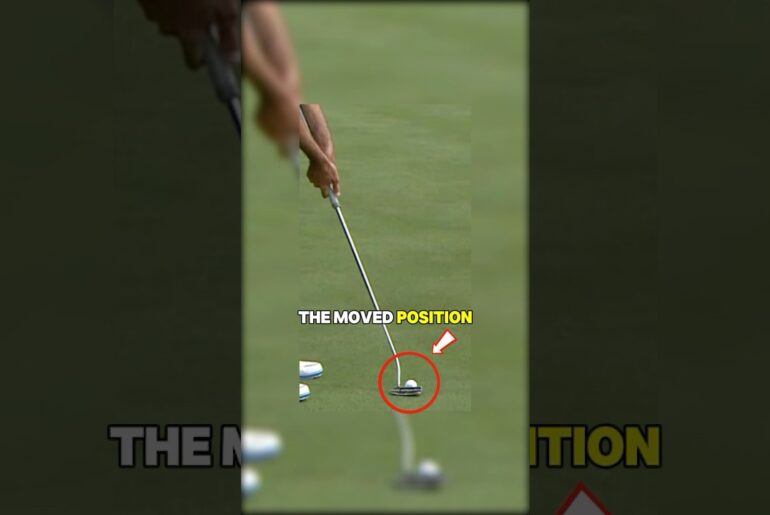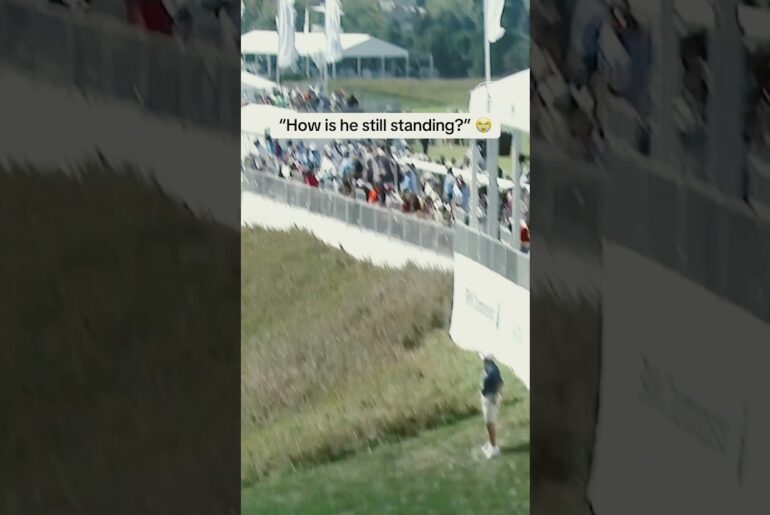“Why Golf Will NEVER Produce Another Bubba Watson…”
Golf today feels like a science lab — launch monitors, swing coaches, biomechanics, data tracking every millimeter of the swing. But once upon a time, golf was pure imagination. It was art. It was feel. And Bubba Watson was its last great artist. The man who cried on camera, swung a pink driver, and hit golf shots that looked impossible even on paper. He didn’t chase numbers, he chased moments. While modern players were being programmed for consistency, Bubba lived for creativity. His game was instinct, not instruction — a throwback to an era where you shaped the ball by vision, not by spin rate. The video begins by asking a haunting question: what happens to golf when imagination disappears? Because in a world obsessed with perfection, the beautifully imperfect players — the emotional, spontaneous, and unpredictable — are slowly going extinct. Bubba wasn’t built by science. He was built by soul.
By the 2020s, the world Bubba once ruled no longer existed. Golfers were trained like machines, their swings optimized by computers before they even hit puberty. Feel was being replaced by formulas. In 2022, Bubba left the PGA Tour for LIV Golf, stepping into a new chapter focused on family and purpose. But his departure felt symbolic — as if golf’s last true artist had exited the stage. Today’s players are precise, calculated, and robotic, but something’s missing: soul. Bubba Watson reminded the world that golf isn’t just about numbers; it’s about imagination, emotion, and courage. He didn’t play perfect golf — he played unforgettable golf. And when he walked away, the game lost a piece of its heart. Bubba Watson wasn’t just a champion. He was the final echo of a vanishing art — the last true “feel” player in a world built on science.
Golf used to be unpredictable, a canvas painted with imagination, courage, and heart. It wasn’t about swing coaches or launch monitors. It was about vision, feel, emotion. And in that world, one man stood out like a spark in the dark. Bubba Watson, the kid from Florida who defied every rule, swung a pink driver, and made magic out of thin air. He didn’t have a coach. He didn’t have a formula. He had instinct. Today, golf is ruled by science, numbers, data, and precision. But there was a time when one man proved that you could win with nothing more than creativity and faith. From the pine straw at Augusta to his emotional tears on live TV, Bubba’s story isn’t just about golf. It’s about the death of artistry in a sport now built by machines. This is the story of how the last great field player conquered golf and why we may never see another like him again. Welcome to Golf Facts. Golf today feels like a science lab, launch monitors, swing coaches, biomechanics, data tracking every millimeter of the swing. But once upon a time, golf was pure imagination. It was art. It was feel. And Bubba Watson was its last great artist. The man who cried on camera, swung a pink driver, and hit golf shots that looked impossible even on paper. He didn’t chase numbers. He chased moments. While modern players were being programmed for consistency, Bubba lived for creativity. His game was instinct, not instruction. A throwback to an era where you shape the ball by vision, not by spin rate. The video begins by asking a haunting question. What happens to golf when imagination disappears? Because in a world obsessed with perfection, the beautifully imperfect players, the emotional, spontaneous, and unpredictable are slowly going extinct. Bubba wasn’t built by science. He was built by soul. Bubba Watson’s story doesn’t begin in the manicured fairways of elite country clubs. It starts in the dusty town of Baghdad, Florida, a humble bluecollar community where dreams were simple and golf was a backyard hobby, not a career plan. His father, Jerry Watson, Senior, was a green beret, tough as nails, and the one who handed Bubba his first club. The name Bubba came from a joke. His dad thought he looked like NFL player Bubba Smith. But that name stuck and so did the grit. From day one, Bubba wasn’t like other kids. He had no instructors, no structured training, and no exposure to golfmies. He taught himself by swinging until dark, by trial and error, by imagination. While others studied golf’s rule book, Bubba tore it up. Every shot was a new experiment, every miss a lesson. Those roots, raw, emotional, unpolished, would define the most unconventional champion golf had ever seen. In today’s world, golfers spend thousands perfecting their mechanics under expert coaches. Bubba Watson had none of that. He was a one-man laboratory learning by curiosity and instinct. Without cameras or data screens, he learned to manipulate the ball using nothing but feel. Bubba wasn’t just a left-handed golfer. He was an artist painting with a driver. His swing was wild, long, loopy, and completely unique. Coaches would have called it wrong, but that wrong became his secret weapon. He didn’t care about swing planes or launch angles. He cared about possibilities. Bubba visualized golf shots that others couldn’t even imagine. Hooks, slices, sky high flops that bent through trees like boomerangs. This homemade genius redefined what creativity in golf could mean. He didn’t play the course, he talked to it, shaping shots like brush strokes. Bubba’s game wasn’t about control. It was about freedom. When Bubba decided to chase golf professionally, nothing came easy. He wasn’t a country club prodigy. He was an outsider. After dominating at Milton High, he attended Faulner State Community College where his natural distance drew attention. From there, he transferred to the University of Georgia, one of the top college programs in the nation. Among the polished, technically trained bulldogs, Bubba stood out like a storm in a lab. His raw power and fearless creativity caught everyone’s eye. Turning pro in 2002, he had to grind for years on the nationwide tour, living out of suitcases, missing cuts, and scraping by on small checks. But he kept believing in his vision, his way. No coaches, no analytics, just feel. By 2005, he finally earned his PGA Tour card, and golf was about to meet its most unpredictable star. Bubba Watson wasn’t the future of golf, he was its rebellion. Bubba’s philosophy could be summed up in one line, “Grip it and rip it.” While his peers focused on precision and control, Bubba chased creativity and power. He could outdrive nearly anyone on tour, leading the PGA in driving distance right from his rookie year. Yet, what made him special wasn’t just how far he hit it, but how he hit it. He’d intentionally hook or fade drives 40 yards around trees just because he saw the shot in his mind. He didn’t aim for the safe center of the fairway. He aimed for the extraordinary. His power wasn’t mechanical. It was emotional. Every swing had intent, imagination, and unpredictability. Fans came to see Bubba not because he was perfect, but because he was thrilling. Watching him was like watching controlled chaos. One moment disaster, the next pure genius. In a game of calculators, Bubba Watson was still using crayons. Bubba Watson wore his heart on his sleeve. When he won, he cried. When he lost, you saw the pain. In a sport known for poker faces and polite handshakes, Bubba showed the full spectrum of human emotion. He wasn’t afraid to let fans see who he truly was. His pink driver became his signature. Bright, defiant, and deeply personal. It wasn’t just for style. It honored his father’s battle with cancer and raised money for charity. Every time Bubba stepped on the course, you felt something. Joy, frustration, awe. He brought humanity back into a sport that had become mechanical. The cameras loved him because he never hid behind rehearsed answers or fake smiles. Golf didn’t always know how to handle his intensity, but fans did. They saw themselves in his emotion. The dreamer, the struggler, the believer who never stopped caring. Bubba’s first PGA Tour victory came at the 2010 Travelers Championship, and it was everything his story represented. Raw, emotional, unforgettable. In a playoff against veterans Cory Pav and Scott Verplank, Bubba held his nerve and secured the win. But the celebration wasn’t loud. It was heartbreaking. He broke down crying on live TV, dedicating the victory to his father, who was battling cancer. A few months later, his father passed away. That pain became part of Bubba’s DNA. Every swing afterward carried a weight, a purpose. The world saw his tears as weakness, but they were strength, the kind only love can give. From that point forward, every victory and every near miss felt personal. He wasn’t just chasing trophies. He was honoring a memory. Bubba wasn’t playing for stats. He was playing for something eternal, connection. Then came Augusta, 2012. The world watched as Bubba faced Lewis Heisen in a playoff at the Masters. On the second extra hole, Bubba found himself deep in the pine straw, trees blocking every angle. For most players, it was over. For Bubba, it was an opportunity. He visualized a 40-yard hook that defied logic, a shot that curved around trees and somehow landed on the green. And then he did it. The gallery exploded. Commentators couldn’t believe it. Physics couldn’t explain it. That wedge shot became an instant legend, one of the boldest and most imaginative in Mast’s history. Minutes later, Bubba Watson slipped on the green jacket, tears streaming down his face. A self-taught dreamer had conquered Augusta National with nothing but imagination and faith. In that moment, golf wasn’t science. It was poetry, and Bubba was its author. If 2012 made him a legend, 2014 made him untouchable. Bubba Watson’s second Mast’s win proved that his first was no fluke. He outlasted young Phenom Jordan Spe and proved that creativity could still dominate modern golf. That year, he also won the Northern Trust Open and the WGC HSBC Champions in Shanghai, where he held a bunker shot on the 72nd hole to force a playoff and then drained a 20ft birdie to win. It was pure Bubba, dramatic, fearless, emotional. By 2015, he had reached world number two with millions of fans and two green jackets to his name. Off the course, his family life flourished. He and his wife Angie adopted two children, Caleb and Dakota, and poured themselves into charity work. Bubba had everything. Fame, fortune, family. But behind the smile, a new realization grew. The sport he loved was changing fast, and his kind of golf was disappearing. By the 2020s, the world Bubba once ruled no longer existed. Golfers were trained like machines, their swings optimized by computers before they even hit puberty. Feel was being replaced by formulas. In 2022, Bubba left the PGA Tour for LIIV Golf, stepping into a new chapter focused on family and purpose. But his departure felt symbolic, as if golf’s last true artist had exited the stage. Today’s players are precise, calculated, and robotic. But something’s missing. Soul. Bubba Watson reminded the world that golf isn’t just about numbers. It’s about imagination, emotion, and courage. He didn’t play perfect golf. He played unforgettable golf. And when he walked away, the game lost a piece of its heart. Bubba Watson wasn’t just a champion. He was the final echo of a vanishing art. The last true feel player in a world built on science. Bubba Watson’s story is more than highlights and trophies. It’s a reminder of what golf once was. A game where emotion mattered more than data. Where instinct beat algorithms and where one man’s imagination could bend reality itself. Bubba didn’t just hit golf shots. He created moments that people will never forget. In an era now obsessed with perfect swings and perfect numbers, Bubba represented something raw, something human. He was proof that Hart still has a place in a world run by technology. Maybe that’s why when he walked away, it didn’t just feel like a retirement. It felt like an ending. The end of golf’s poetry. the end of its mystery, but also the beginning of a legend that will live forever. Because no statistic can measure what Bubba gave this game, soul. If you enjoyed this story, don’t forget to subscribe to Golf Facts, where we bring you the truth, the emotion, and the stories that make golf more than a sport. They make it art.







